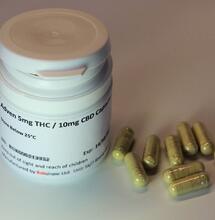Dehumidification and cooling of the grow room
_11zon.png)
Appropriate climatic conditions are essential on the road to a successful harvest – not only in regards to growing cannabis. However, maintaining these conditions is often a demanding task that both home growers and large producers need to solve. What happens most is that we have to cope with high temperatures and high relative humidity in our grow rooms. These two variables are closely linked and there are many ways to deal with them. In the following article we will examine them in greater detail.
Air humidity
Air humidity is tells us how much water is contained in a certain amount of air that surrounds us. Most of you are probably familiar with measuring the air humidity with percent. This is the relative or proportional humidity of air, which expresses the ratio between the actual amount of vapor in the air and the amount that the air could absorb under the same temperature and pressure. If it were fully saturated with water vapor, the relative humidity would be 100%. The second widely used identifier is the so called absolute air humidity. It expresses the weight of steam contained in a particular unit of air – in Europe, the weight of water vapor in grams per cubic meter of air is most often used.
The higher the air temperature, the more vapor air can absorb. If your grow room temperature is 24 °C and the absolute air humidity is 13 g/1 m3, the hygrometer would measure the relative air humidity of about 60%. Raising the temperature to 28 °C and keeping the absolute humidity at the original value would reduce the relative humidity to 50%. Thus, if the absolute air humidity is the same, the relative air humidity can either be lowered by increasing the air temperature, or conversely by lowering the air temperature.
This is why the relative humidity in the grow room increases rapidly when your lights are off. The temperature is dropping while the absolute air humidity remains the same. And what is more – during the final stage of flowering large amounts of water are transpired into the air by plants, increasing the absolute humidity even more. When the temperature drops the increase in relative humidity is even more prominent.
The dew point temperature is also important for growers. This term refers to the temperature when the air is fully saturated with water, i.e. when the relative humidity of the air is 100%, as we have mentioned above. When the surface temperature drops below the dew point, water vapor condenses into water.
If the temperature in your grow room was 28 °C and the relative humidity was 60%, the dew point temperature would be 19.5 °C. This means that if the temperature of any surface drops to a dew point, the vapor on it would begin to condense into water. Thus, once the temperature of the leaves‘ surface or of flowerpot’s wall drops to 19.5 °C, water begins to condense on them. And that is definitely not good.
Reducing air humidity
As indicated in the previous paragraph, the reduction of relative air humidity can be achieved by raising the temperature in the grow room. This makes sense especially when the temperature drops significantly after turning the lights off – by more than 8 degrees Celsius. In this case, it is convenient to heat the room during the dark period and maintain the difference between day and night temperature at a maximum of 5–8 °C. The higher the difference between day and night temperature, the faster the plants grow.
Thus, it is possible to control the height of your plants by adjusting day and night temperatures. It is, however, recommended to increase the difference between day and night temperatures during the flowering stage. Although in this case it is assumed that you have a high-quality dehumidification device that is able to extract the required amount of water or, more precisely, water vapor. In case you have a small grow room, it will do better with keeping the difference between day and night temperature as low as possible, say 2–5 °C. This way you can at least partially reduce the relative humidity during the night.
For reliable dehumidification, the grow room must be equipped with air conditioning, dehumidifier, or a combination of both. Every air conditioning unit has a specific dehumidification capacity. When the air is cooled, the temperature of the evaporator gets below the dew point, causing the water vapors condense into water, which is then released by the conditioner outside the grow room. More advanced air conditioners have higher dehumidification capacity, which is what I recommend when choosing air conditioning.
Dehumidifier
The most reliable way to reduce moisture in your grow room is to use a dehumidifier. It can be used not only on its own, but also as a support for the dehumidification capacity of air conditioning unit. A dehumidifier has generally higher dehumidification capabilities than air conditioning with a dehumidification unit. There are several viable options when choosing a dehumidifier. Passive dehumidifiers with absorbent features are usually available in stores. These models are absolutely insufficient for indoor growing. Remember that almost 100% of the water you use to irrigate the plants is released back into the atmosphere as vapor. The larger the plants, the larger amount of water vapor needs to be drained from the air. This is achievable only when using active dehumidification.
Most dehumidifiers intended for indoor use are primarily designed to remove average air humidity at normal room temperature. This is not enough for your grow room. But even a weak dehumidifier is better than none, and any active dehumidifier from the supermarket will suffice when growing on one square meter. In combination with air conditioning, even these ordinary dehumidifiers can work well in medium-sized growing tents. Nonetheless if you want a truly reliable dehumidifier for a large grow room, pick one from a range of manufacturers that focus on dehumidifying areas used for growing plants or on dehumidifying industrial premises.
The power of a given dehumidifier is usually measured in the amount of liters of water which it is able to remove from the air during 24 hours. It is advisable to check the temperature and relative humidity at which the dehumidifier is able to remove such amount moisture. What happens often is that the dehumidification capabilities are measured under conditions which you will never achieve in the grow room and which artificially increase dehumidification performance. An ideal scenario is when you know how many liters of water the dehumidifier can remove at temperature around 25 °C and a humidity between 60 and 80%.
Cooling
Essentially, there are two ways to cool air in the grow room. Either you take the warm air out of the cultivation space and replace it with cooler air from outside, or use air conditioning. The first option is widespread among home growers. The basic condition for its proper functioning is that the temperature of air sucked in or blown into the grow room is not higher than the temperature you want in your cultivation area. For a very basic installation, it is enough to have a sufficiently strong exhaust fan.
It should have at least 40 times stronger air flow than the volume of the growing area. For 2 x 2 x 2 meter grow room, you would need a fan with air exchange power of 240 m3/ hour. Of course, there needs to be an opening in the grow room through which fresh air can be drawn in under pressure. For even more efficient cooling, install a second air intake fan. It can have half the power of the exhaust fan.
As we have already said, fan-only cooling is effective in places where outside air is cooler than the desired temperature inside the grow room. Just be careful during extremely hot days. In the short term, this problem can be solved by placing a wet towel or other fabric near the opening. As long as it is sufficiently wet, it will cool down the air flowing around. If you manage to let some water flow slowly through the towel, the cooling effect would be better and last longer.
This technique called wet wall and is used to make cooler large greenhouses. Air is blown into them through blocks of paper that are constantly moistened. The cooling effect is excedent in this case. For indoor grow rooms, however, the most suitable solution is an air conditioning unit.
Air conditioning
The air conditioning needs to have required power to work properly. When purchasing an ordinary room air conditioner, it is enough to pick the cooling capacity according to the room size, or more precisely its volume. Normally, one cubic meter requires 30 watts of cooling capacity.
However, this is not enough when choosing the right air conditioner for the grow room. In this case, it is necessary to know how many watts are produced by lifting source, or by other installed devices (e.g. CO2 generator). If you have six 600 W sodium lamps in your grow room, you need a cooling capacity of at least 3 600 W.
In order to ensure that the air conditioner does its job properly, count with additional 30 W for each cubic meter of the grow room. For example, if the above-mentioned cultivation area had 30 m3, add 900 W. The resulting required cooling capacity in this case is thus at least 4 500 W. BTU (British Thermal Unit) is used as a unit of measurement for cooling. 1 Wh (Watt Hour) is equal to 3.412 BTU.
Multiply calculated 4 500 W by 3.412 and you will get 15 355 BTU – this is the minimum cooling power needed to cool a 30 m3 growing area with six 600 W sodium lamps. It is important to note that it is better to use a little stronger cooling power, which means that air conditioning with a cooling capacity of 20 000 BTU would be an even better solution in this case. However, the air conditioner should not be overdesigned, because the intake of too cold air could cause its power failure.
The optimal solution
The best way to achieve optimal temperature and humidity in your grow room is the combination of air conditioning, heating, dehumidification and air humidification. All four features must match perfectly and should be ideally controlled by a single control unit. In this case, you would reach ideal climatic conditions during every stage of the life cycle of your plants, and you will be able to achieve them at any time.



